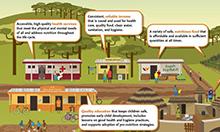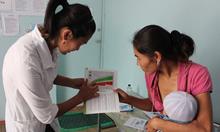
Getting nutrition commitments cemented into other sectors' plans and strategies at global, national and program levels will demand lengthy and sensitive negotiation, backed up with robust evidence of how we can help. Beyond just collecting data, we need to actively use this data to make better choices and inform and advocate decision-making at the policy level.
-Global Nutrition Report 2017 (Development Initiatives 2017)
Knowledge translation (KT) has emerged as a paradigm to…start closing the "know-do" gap. KT is defined as the synthesis, exchange, and application of knowledge by relevant stakeholders to accelerate the benefits of global and local innovation in strengthening health systems and improving people’s health.
-World Health Organization (WHO 2018)
In almost every context, policymakers are hungry for evidence to support their policy agenda—no one wants to back a proposition that is not going to work (Bogenschneider and Corbett 2010). Good evidence is a crucial part of the policy-making process even when politics and personal interests come into play.
That said, there is often a misalignment between the priorities of those who produce evidence and those who define and enforce policy. Policymakers need timely, relevant, and accurate information to support policy and strategy formulation (Marasini and Mugenyi 2016), but researchers may have different expectations of what research questions are relevant, the level of collaboration that is appropriate, and the timeliness of results (Thompson 2011). Although some policymakers can utilize original research, most do not have the time to identify credible sources, decipher academic jargon, or translate evidence into day-to-day decisions about policies and budgets.
Efforts to close this gap have been called many things (knowledge translation, translational research, evidence-based policymaking), but, at their core, the goals are the same—to supply useful, credible, and timely evidence that supports the creation of effective policies and programs. This brief describes lessons and experiences from USAID’s Strengthening Partnerships, Results, and Innovations in Nutrition Globally (SPRING) project in better connecting program evidence and nutrition policy.
What SPRING Has Learned
Working in 13 countries from 2012 to 2018, the SPRING project supported policy processes across social and behavior change communication (SBCC), anemia prevention, food fortification and supplementation, and antenatal care, among other areas. In each case, our staff produced primary evidence or helped synthesize secondary data and evidence from other sources before converting it into easy-to-use formats for stakeholders making policy decisions.
Across Bangladesh, Ghana, Kyrgyz Republic, Nepal, Sierra Leone, and Uganda, we have learned what works and what doesn’t when attempting to translate evidence into policy. We have also identified hurdles that can impede success:
- Use of evidence in policy making can be heavily influenced by personal and political relationships; evidence developed outside of these relationships is less likely to be used.
- It takes time to produce usable evidence and may not keep pace with a fast-moving policy environment.
- Most research is not designed to inform the chief concerns that policymakers face daily within the policy and planning cycle. In addition, most research is not written in a language or format that will capture the attention of technical staff who support policy development and adherence.
- Research findings are often reported for regions or countries, yet there can be tremendous variation within and between regions and countries.
SPRING found several ways to clear these hurdles, as described in the following section.
Turning Evidence into Policy
1. Build solid working relationships with in-country partners.
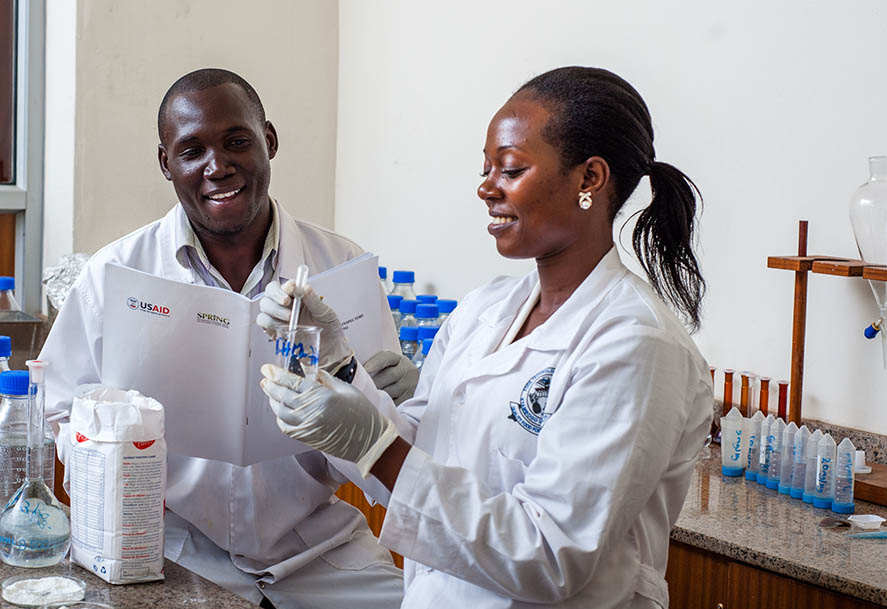
To ensure that evidence is used to develop strategies and policies with widespread support, it is essential that the process engage in-country counterparts (government policymakers, USAID missions, other donors, and implementing partners). These counterparts have local knowledge and relationships that are key to the success of the policy development process, and wherever possible, should be responsible for leading and driving forward these efforts. Developing strong working relationships with key in-country counterparts from the start of SPRING’s work has allowed us to design more relevant research and improve the chances that findings are used during policy decision making.
In Uganda, based on needs articulated by the Ministry of Health (MOH), SPRING helped revitalize the National Anemia Working Group and the National Working Group on Food Fortification. We supported quarterly meetings, which served as a forum for sharing and discussing evidence and related policy documents. We also organized industry visits for working group members to gain a better understanding of the food industry and food fortification process, which helped build support for expanding fortification efforts. With government leadership and SPRING's technical support, the two working groups developed five-year, multi-sectoral strategies to guide food fortification and anemia prevention and control efforts.
In Sierra Leone, SPRING and the Ministry of Health and Sanitation (MOHS) worked together to conduct a landscape analysis with existing data and create evidence-based and context-specific strategies to reduce anemia. This work helped SPRING build partnerships with other policymakers within the government, which increased their trust of findings from the landscape analysis. Ultimately, the government used these findings in the development and implementation of the anemia prevention and control strategy.
Similarly, in the Kyrgyz Republic, SPRING worked with the Republican Center for Health Promotion, a division within the MOH, to organize a three-day strategy review and planning meeting. The meeting helped build our relationship with the MOH, align stakeholders’ roles and responsibilities, and determine next steps to finalize and implement a national strategy for nutrition SBCC.
In all three countries, SPRING invested time and energy in developing working relationships with government counterparts to increase the use of data for policy development.
2.Align the evidence dissemination cycle with the policy cycle.
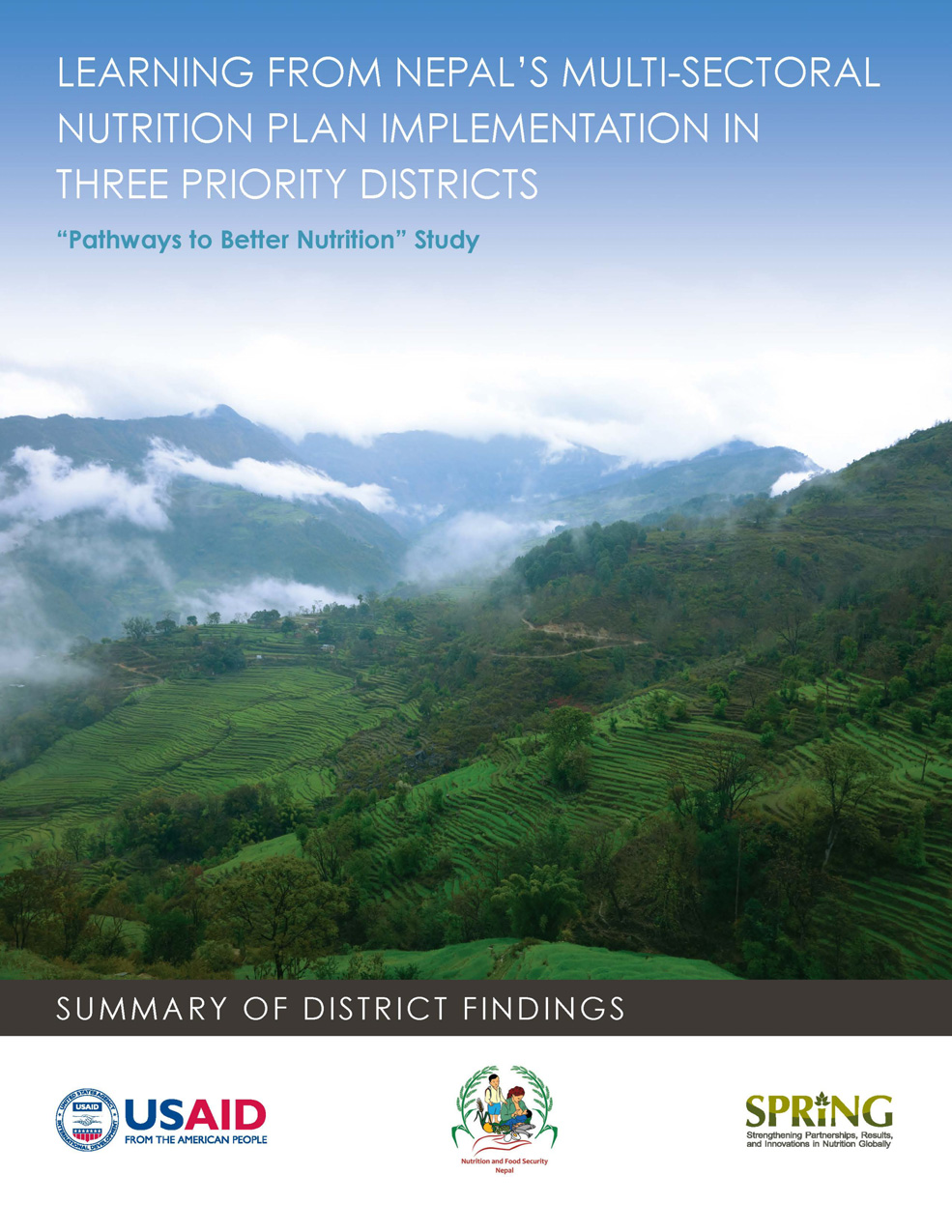
Good evidence, even when designed in concert with stakeholders, is useful only if shared in time to inform policy or work-plan formulation. SPRING found that most governments develop policies within a three- or five-year cycle and also require sectors to complete annual work plans within these policy frameworks.
In Nepal, SPRING received feedback that the lag time in producing results from our Pathways to Better Nutrition (PBN) study was too long to be useful to the nutrition secretariat (Pomeroy-Stevens et al. 2016). In response, SPRING began producing quarterly updates on what we were finding, along with interim briefs on priority topics and current policy concerns. Members of the National Planning Commission, the entity responsible for coordinating nutrition stakeholders, stated that these periodic updates (along with the final results) were helpful for identifying and addressing challenges with implementing Nepal’s National Nutrition Action Plan (NNAP) and in formulating the next iteration of the policy (Marasini and Mugenyi 2016).
This example demonstrates that the timing of evidence delivery is critical to its use. Although this timing is challenging, maintaining strong relationships with policymakers means you will be informed about when to produce results to ensure that information is ready when it is most needed.
3.Involve technical staff in research design, results, and dissemination.
Over the course of SPRING’s support to governments, we often heard about the mismatch between what evidence is produced (not just by SPRING, but also by other partners) and what is needed to inform policy decisions. We also heard good ideas from government technical staff that helped us better target study questions, design, results, and dissemination to the immediate needs of that country.
In Uganda, SPRING and partners worked with the Micronutrient Technical Working Group (MN-TWG), which included technical staff from several sectors. Together, we tailored the design and implementation of a study on the cost effectiveness of micronutrient powder (MNP) distribution to the needs of MN-TWG. As a result, the national guidance is owned by the government and endorsed by a diverse group of stakeholders.
At the district level in Uganda, Nepal, and Ghana, SPRING used the District Assessment Tool for Anemia (DATA) to bring together technical staff, program management staff, and other district stakeholders from multiple sectors to collect and analyze data for the formulation of a comprehensive response to anemia. Although DATA was not designed to influence national policy, it provided an opportunity for district stakeholders to drive their own evidence collection and identify what policy changes they would want to advocate for to support effective anemia programming.
In Uganda and Nepal, we refined SPRING’s PBN study research questions in collaboration with key government stakeholders from each country to ensure that the results would be useful for the next national nutrition policy and financing cycle. This also helped us avoid duplicating research being undertaken by other government partners. We collected data with the nutrition coordination committees and seven key ministries in both countries. We then shared the datasets with planning and budgeting offices from each of the relevant ministries, along with guidance on how they could themselves analyze the allocations and expenditures to suit their own needs. Involving technical staff early on in this process has helped both countries continue to track nutrition budget data at the national level.
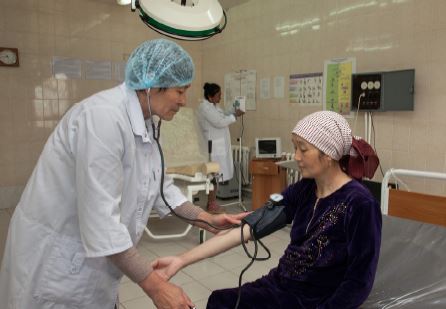
In the Kyrgyz Republic, SPRING and government technical staff conducted formative research that revealed that health workers did not fully adhere to existing anemia prevention and treatment protocols. The results became a catalyst for revising the Kyrgyz Republic National Anemia Technical Guideline and Protocol to ensure that health workers provide (1) iron-folic acid to all women of reproductive age, all pregnant women throughout the course of their pregnancy, and for three months after the delivery of a baby; and (2) recommend presumptive deworming for children and women (including during pregnancy).
SPRING’s efforts to tailor research design and language to policy needs in each context yielded more relevant evidence and greater use of findings.
4. Create context-specific evidence and translate evidence-based policy into practical tools for implementation.
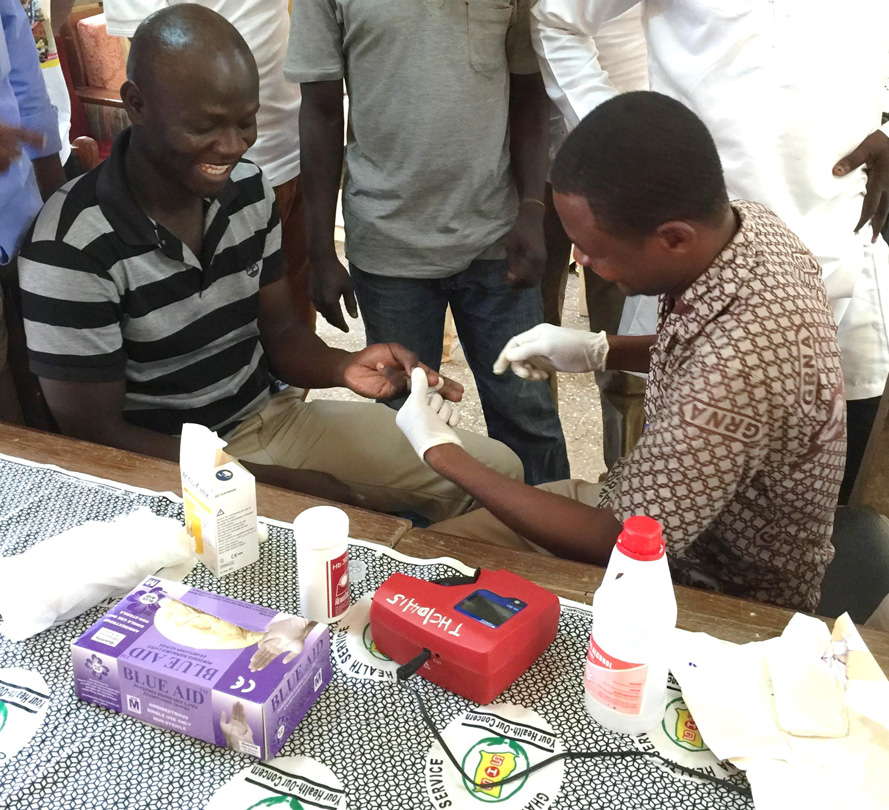
SPRING made it a priority to provide evidence at the level of implementation across our evaluation and research portfolio—this means presenting results for the community, ward, or district, not simply national averages. This includes documenting the influence of farmer nutrition schools on essential nutrition actions and essential hygiene actions in Barisal and Khulna divisions (Bangladesh); the impact of Nigeria’s Community Infant and Young Child Feeding Counselling Package in Kajuru; and the impact of community media in Maradi (Niger), Keonjar (India), and the East region of Burkina Faso.
In addition to the production of context-specific evidence, SPRING has also helped transform evidence-based policy into practical tools for implementation. In Ghana, SPRING worked with the Ghana Health Service's Micronutrient Task Team to create a comprehensive anemia training curriculum, built on the national anemia policy, that would help increase the capacity of health workers and community health volunteers to implement the policy. The trainings conducted with this curriculum in the northern region of Ghana improved critical skills including nutrition counseling for anemia prevention, identification of anemia, hemoglobin testing, iron-folic acid supplementation and treatment regimes, and infection prevention strategies.
In Uganda, SPRING and partners worked with the MN-TWG to develop training materials, monitoring and evaluation tools, and implementation processes for distribution of MNPs. These efforts are facilitating introduction of draft national integrated micronutrient guidelines.
Finally, in the Kyrgyz Republic, to support updated national policies on anemia prevention and treatment, deworming, and supportive supervision (among other topics), we created a comprehensive training curriculum and training-of-trainers manual that the MOH is now using. SPRING also developed complementary job aids and communication materials. In addition, while the MOH worked to develop an urban SBCC strategy, we tested approaches on the ground, feeding findings back to the MOH for consideration as they finalized the strategy.
Although not every project will have the time or the mandate to put policies into practice, collecting data and presenting context-specific results beyond the national average is an important first step.
Looking Forward
Formulating national policies can be an arduous process—evidence that is too dense, irrelevant, or poorly timed is not likely to be useful for policy creation. SPRING’s work over the last seven years in Africa, Asia, and Latin America has helped us understand context-specific and universal strategies for translating evidence into policy.
Those tasked with developing national policies in governments are highly trained and respected in their fields, but often bear overwhelming workloads with many competing priorities; they need evidence that is easy to understand, useful, and timely. As with any good research, the process will start with a thorough understanding of the context and policy environment. It is our hope that future projects working to improve nutrition, particularly nutrition policy, will learn from SPRING’s diverse country experiences generating evidence, building demand for policy change, encouraging the use of evidence to guide policy development, and helping to turn policy into practice. We have found that in order to overcome hurdles and increase chances of success, it is important to build solid working relationships with policymakers, involve partners in evidence generation and dissemination, align the delivery of evidence with policymakers’ needs, and integrate evidence and policy into practical resources.
Download the brief above.
